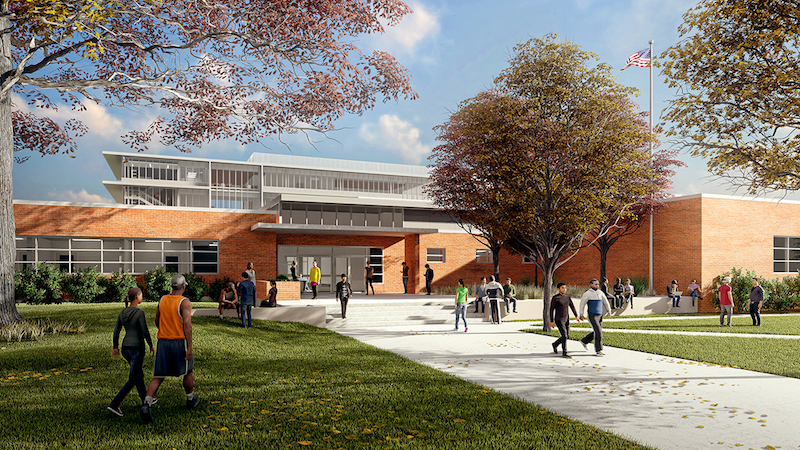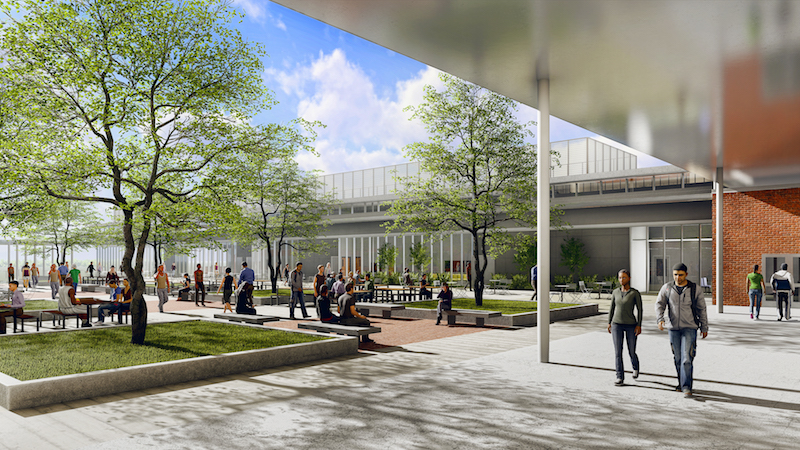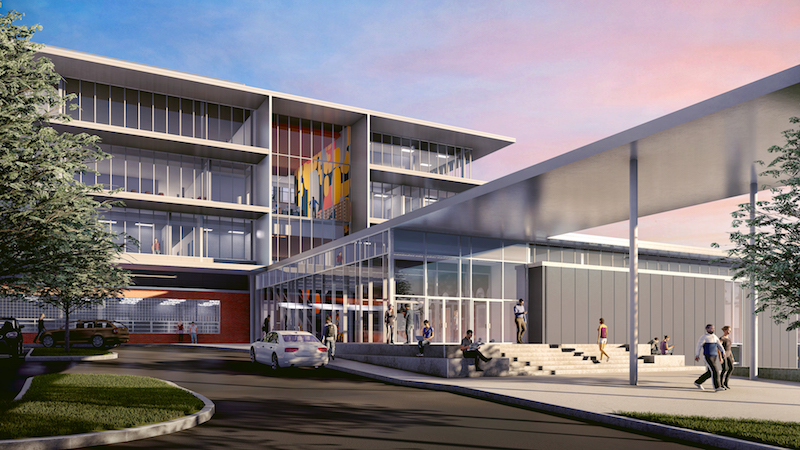The Eastside Memorial Early College High School and International High School, designed by Perkins+Will, will offer a STEM-focused curriculum that will provide specialized education for students with little to no proficiency in the English language.
The school, located in Austin, Texas, will sit on the site of the original L.C. Anderson High School, a historic African American high school that closed in 1971 following federal desegregation. The new facility will blend the old and new by incorporating elements of the original structure into the design scheme. The original, mid-century entrance, band hall, choir room, cafeteria, and an original classroom wing will all be preserved and rebuilt.
 Courtesy Perkins+Will.
Courtesy Perkins+Will.
The entrance to the former location of the gym will become a community center entrance with a gallery that tells the stories of L.C. Anderson High School’s history. The gallery will include a timeline of the former school’s history, legacy medallions, and display cabinets for objects of historical significance.
See Also: University of Miami design/build program receives new immersive-learning facility
The low-profile red-brick building will be complemented by a new, taller section built primarily with metal and glass. The taller, four-story section of the building will feature learning space and student-focused classrooms. The school will feature maker labs, two gymnasiums, a health science lab, and a multi-use outdoor classroom courtyard with a performance stage, quiet reflection areas, and sensory gardens.
 Courtesy Perkins+Will.
Courtesy Perkins+Will.
The $80-million project represents the first ground up high school in Austin Independent School District in almost 20 years. The education facility will make use of passive heating and cooling, natural daylighting, an its proximity to public transportation and bicycle routes in an effort to achieve LEED Silver certification.
The school is slated for completion in 2021.
 Courtesy Perkins+Will.
Courtesy Perkins+Will.
 Courtesy Perkins+Will.
Courtesy Perkins+Will.
Related Stories
| Dec 17, 2010
Alaskan village school gets a new home
Ayagina’ar Elitnaurvik, a new K-12 school serving the Lower Kuskikwim School District, is now open in Kongiganak, a remote Alaskan village of less than 400 residents. The 34,000-sf, 12-classroom facility replaces one that was threatened by river erosion.
| Dec 17, 2010
New engineering building goes for net-zero energy
A new $90 million, 250,000-sf classroom and laboratory facility with a 450-seat auditorium for the College of Electrical and Computer Engineering at the University of Illinois at Urbana/Champaign is aiming for LEED Platinum.
| Dec 17, 2010
How to Win More University Projects
University architects representing four prominent institutions of higher learning tell how your firm can get the inside track on major projects.
| Dec 6, 2010
Honeywell survey
Rising energy costs and a tough economic climate have forced the nation’s school districts to defer facility maintenance and delay construction projects, but they have also encouraged districts to pursue green initiatives, according to Honeywell’s second annual “School Energy and Environment Survey.”
| Nov 29, 2010
New Design Concepts for Elementary and Secondary Schools
Hard hit by the economy, new construction in the K-12 sector has slowed considerably over the past year. Yet innovation has continued, along with renovations and expansions. Today, Building Teams are showing a keener focus on sustainable design, as well as ways to improve indoor environmental quality (IEQ), daylighting, and low-maintenance finishes such as flooring.
| Nov 23, 2010
Honeywell's School Energy and Environment Survey: 68% of districts delayed or eliminated improvements because of economy
Results of Honeywell's second annual “School Energy and Environment Survey” reveal that almost 90% of school leaders see a direct link between the quality and performance of school facilities, and student achievement. However, districts face several obstacles when it comes to keeping their buildings up to date and well maintained. For example, 68% of school districts have either delayed or eliminated building improvements in response to the economic downturn.
| Nov 9, 2010
Just how green is that college campus?
The College Sustainability Report Card 2011 evaluated colleges and universities in the U.S. and Canada with the 300 largest endowments—plus 22 others that asked to be included in the GreenReportCard.org study—on nine categories, including climate change, energy use, green building, and investment priorities. More than half (56%) earned a B or better, but 6% got a D. Can you guess which is the greenest of these: UC San Diego, Dickinson College, University of Calgary, and Dartmouth? Hint: The Red Devil has turned green.
| Nov 3, 2010
First of three green labs opens at Iowa State University
Designed by ZGF Architects, in association with OPN Architects, the Biorenewable Research Laboratory on the Ames campus of Iowa State University is the first of three projects completed as part of the school’s Biorenewables Complex. The 71,800-sf LEED Gold project is one of three wings that will make up the 210,000-sf complex.
| Nov 3, 2010
Park’s green education center a lesson in sustainability
The new Cantigny Outdoor Education Center, located within the 500-acre Cantigny Park in Wheaton, Ill., earned LEED Silver. Designed by DLA Architects, the 3,100-sf multipurpose center will serve patrons of the park’s golf courses, museums, and display garden, one of the largest such gardens in the Midwest.
| Nov 3, 2010
Seattle University’s expanded library trying for LEED Gold
Pfeiffer Partners Architects, in collaboration with Mithun Architects, programmed, planned, and designed the $55 million renovation and expansion of Lemieux Library and McGoldrick Learning Commons at Seattle University. The LEED-Gold-designed facility’s green features include daylighting, sustainable and recycled materials, and a rain garden.














